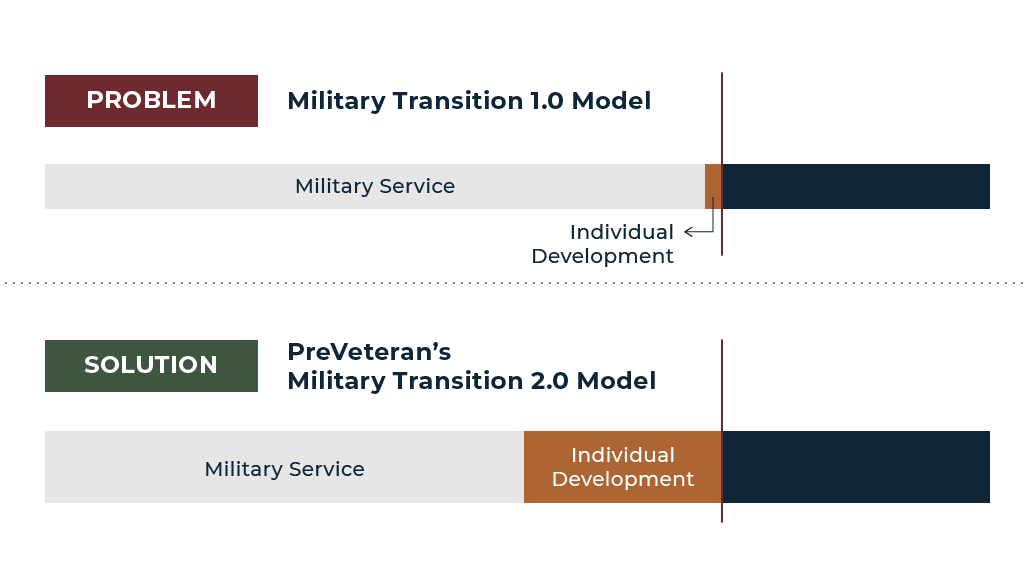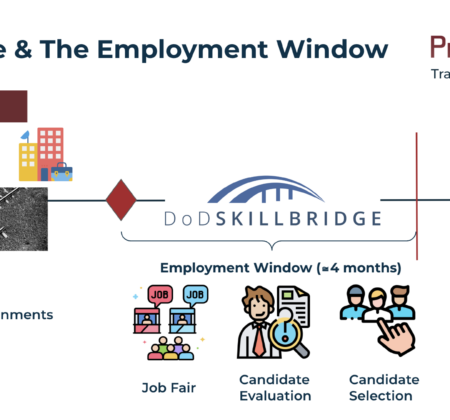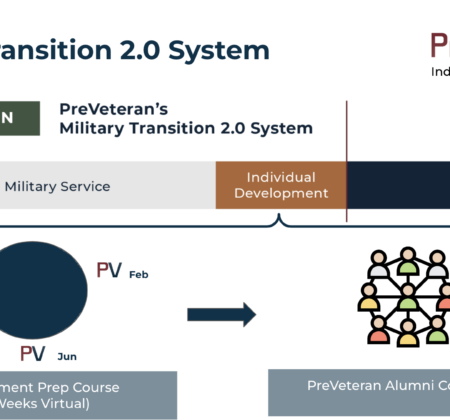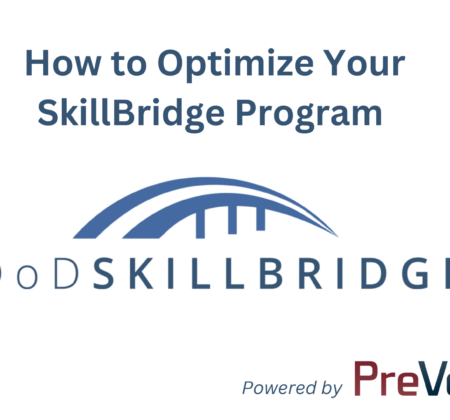The military transition space is in need of transformation, and we at PreVeteran want to lead that charge with our new Military Transition 2.0 model.
The space is in need of transformation because the current Military Transition 1.0 model does not provide you and your family what you need to adequately prepare for life after the military. If you’re a transitioning military member, do a quick inventory of your current thoughts and feelings.
As a uniformed military member, do your thoughts run along these lines?
- You can’t see a clear path forward for what exact steps you need to take to be successful post-military
- You aren’t sure what you want to do post-military
- New ideas enter your mind every day on what you could do post-military
- Each and every day your confidence swings from being very confident about your post-military success to not being confident at all that things will work out
- You don’t want to tell your spouse or significant that you aren’t sure you are terrified that you don’t have the answers this time
- You are significantly more stressed than you lead on to others
As a military spouse, do your thoughts run along these lines?
- You can tell your uniformed spouse or significant other is struggling with thinking through how to transition out of the military successfully
- You’re watching them bounce from one great idea to another on a weekly basis as they think through their transition
- You know they are not sharing the full level of worry they are feeling about preparing for the upcoming transition. It feels like your uniformed service member, who’s always been a good decision maker and rational, is all of a sudden acting irrationally
Why This Is Happening—The Flawed Military Transition 1.0 Model
If you’re looking for specific answers to why this is happening, you’re in luck—we have them for you! The reason why this is happening is because the existing Military Transition 1.0 model, that’s been around since 1991, is flawed.
Before we get into the main points of why, let’s be clear and say we don’t blame the Department of Defense, the Veterans Administration, or any other government agency for this. Any organization that has to help 200,000+ people per year leave the military will have serious challenges.
We will, however, criticize the model and program of record that emerged in the wake of the Transition Assistance Program (TAP) program because it has two huge gaps: it lacks sufficient time and has no individual training component to address your mindset heading into military transition.
Let’s talk about both of the gaps.
Take a look at the graphic below because it explains why those thoughts we wrote about before are entering your mind.
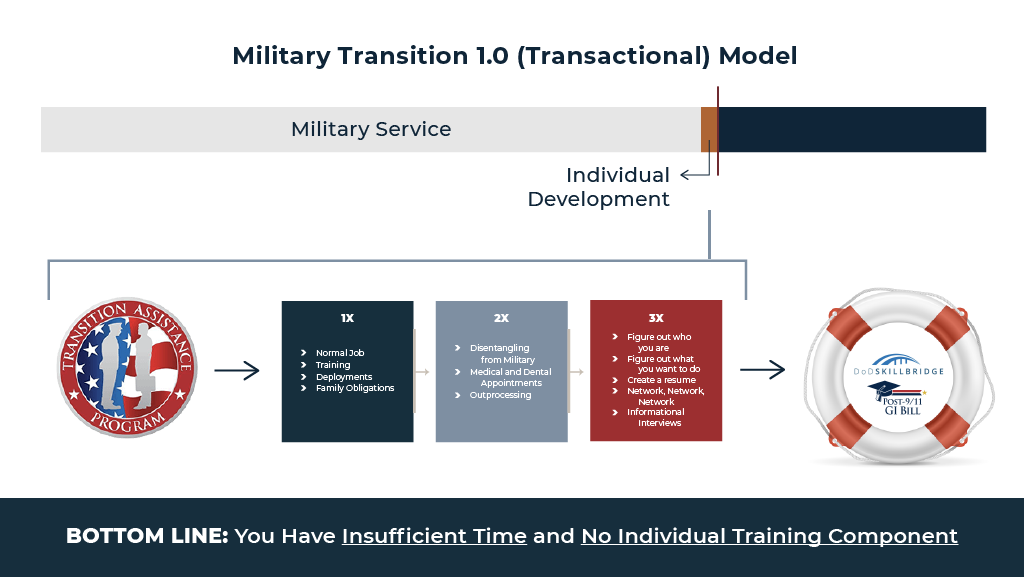
Starting at the top of the chart with the gray “military service” bar, you can see that the current model has you—the uniformed military member—attempting to do all of the necessary “work” within 12 months of your separation or retirement. Yes, current and future program changes further encourage retirees to do the work earlier (within 24 months) but most, if not all, will still do the lion share of the work within 12 months.
Here’s the problem with this timeline that no one talks about—when you’re within 12 months, practically speaking, your workload triples into the following:
- 1X—You’re still doing your job, training, potentially deployments, and continuing your family obligations.
- 2X—You need to disentangle yourself administratively from the military. This includes numerous medical and dental appointments, getting read out from your security clearance, and attending multiple outprocessing briefings over several months.
- 3X—On top of that, you need to figure out who you are and what you want to do post-military. For the majority who want to become employees, that means you need to build a resume, find a mentor, network, and do informational interviews.
Again, from a practical standpoint, guess which activities you’ll tend to do first? Yep, it’s the 1X and the 2X because they have to be completed and they are the most familiar. Likewise, you’ll tend to delay the 3X activities because they are unfamiliar and you’re not given the tools you’ll need to perform these successfully.
This gets us into the individual training component gap within the existing Military Transition 1.0 model. Since 1991, the model has taken a very conventional 20th century education approach to “provide resources” to the uniformed service member. For those of you that have been through the week-long TAP, you know have felt this phenomenon first hand. For a week straight, there’s a torrent of information you’ll intently listen to and parse out the 10-15% of the information that’s germane to your unique situation. It’s exhausting!
By simply “providing resources” the Military Transition 1.0 model is missing an individual training component that includes helping you address your mindset heading into transition.
Let me explain why this mindset piece is so important.
All learning has to be contextual in order for the learner—you—to really utilize the information you’re given. This is true in any learning environment. The problem with the post-military employment preparation piece specifically is that the military environment you’re leaving and the private sector environment you’re entering is very different.
And whether you’ve been in the military environment for four years or 40 years, your mindset has been deliberately trained—or tuned—to flourish in the military environment.
That doesn’t mean you won’t be successful post-military, it just means that you’ll need to change your mindset once you leave the military to better flourish outside the military. Since 1991, transitioning military members have struggled with these significant differences—it’s in the data—but were forced to make the inevitable change because they had to. Most make it through this painful transition eventually after some time. We’ve all seen the veterans who have not made this transition and seem to be stuck in that environment despite no longer being in the military.
Our PreVeteran Military Transition 2.0 Model
Now that you know the gaps in the existing Military Transition 1.0 model, let’s talk about our PreVeteran Military Transition 2.0 model and how it addresses the insufficient time and gaps in individual training.
First, from a time standpoint, take a look at the orange block on the back end of your “military service” bar. It’s much longer. That’s because in our PreVeteran Military Transition 2.0 model, we’re seeking you military members and military spouses who have a minimum of 1-3 years before your separation or retirement.
With sufficient time built purposefully into the model, the next critical enabler is an individual training component. Since military transition is a journey, our model accommodates this journey by helping you orient yourself, navigate to a more successful post-military life, and iterate this approach to keep fine tuning it. Here’s how that works in our Military Transition 2.0 model.
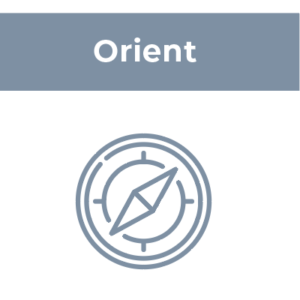 Step 1—Orientation. To start any journey, including your transition out of the military, you need to know where your starting point is. Hence the need for getting oriented within the current environment as a critical first step. In PreVeteran, this orientation takes place in two parts. One, understanding your mindset and approach to thinking and decision making. And two, understanding how the existing Military Transition 1.0 model is influencing your decision making process.
Step 1—Orientation. To start any journey, including your transition out of the military, you need to know where your starting point is. Hence the need for getting oriented within the current environment as a critical first step. In PreVeteran, this orientation takes place in two parts. One, understanding your mindset and approach to thinking and decision making. And two, understanding how the existing Military Transition 1.0 model is influencing your decision making process.
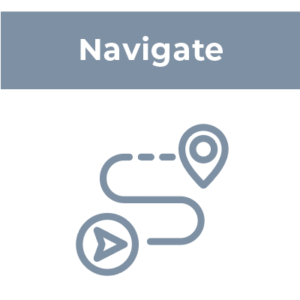 Step 2—Navigation. Once you’re oriented and comfortably have your feet beneath you, it’s time to begin efficiently and effectively navigating from where you are now to successful post-military employment. PreVeteran has two flagship courses it’s been piloting for almost two years that will help you change the way you think, align to the private sector’s needs and wants, and also negotiate the highest-possible salary and benefits using our proven method. In other words, these programs give you back your autonomy and get you firmly in the driver’s seat.
Step 2—Navigation. Once you’re oriented and comfortably have your feet beneath you, it’s time to begin efficiently and effectively navigating from where you are now to successful post-military employment. PreVeteran has two flagship courses it’s been piloting for almost two years that will help you change the way you think, align to the private sector’s needs and wants, and also negotiate the highest-possible salary and benefits using our proven method. In other words, these programs give you back your autonomy and get you firmly in the driver’s seat.
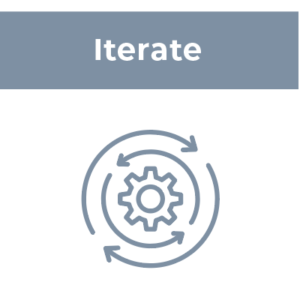 Step 3—Iteration. Once you’ve started navigating toward your first post-military employment opportunity and learning about the potential opportunities, you’re quickly going to find out things are a bit different than you had assumed when you went in. This is why iterating your approach is emphasized in our flagship courses and becomes such an important enabler to your success. When it comes to post-military employment, there’s no such thing as a “one and done” approach. Rather, it will take multiple iterations over time to really zero in on the company, role, and level that meets you and your family’s needs.
Step 3—Iteration. Once you’ve started navigating toward your first post-military employment opportunity and learning about the potential opportunities, you’re quickly going to find out things are a bit different than you had assumed when you went in. This is why iterating your approach is emphasized in our flagship courses and becomes such an important enabler to your success. When it comes to post-military employment, there’s no such thing as a “one and done” approach. Rather, it will take multiple iterations over time to really zero in on the company, role, and level that meets you and your family’s needs.
Military Members / Military Spouses—Get Started On Your Military Transition 2.0 Journey Today
Whether you’ve got 5 months or three years until separation or retirement, get started on your military transition journey today by taking our Employment Readiness Quiz. We know that one of the toughest parts of preparing for military transition is figuring what specific steps need to be taken to be successful. Likewise, you’d also like to know the actions you may be taking that aren’t helping you land the desired post-military job.
Wouldn’t it be nice to know what works and what does not? Our quiz can help you parse out those critical distinctions and show you another more efficient and effective path you can follow that will reduce your stress and increase your confidence in truly taking command of your military transition.
PreVeteran is a company committed to helping military members and their families better prepare themselves for post-military employment in the private sector. PreVeteran takes a highly individual, cognitive neuroscience-based approach to this challenge by helping these individuals regain autonomy in their thinking and decision-making process. If you’re interested in learning more about our approach, contact us at info@preveteran.com and someone will get back to you right away.
